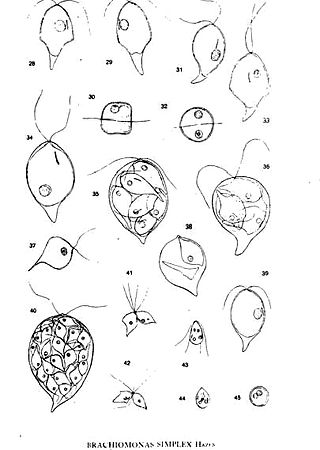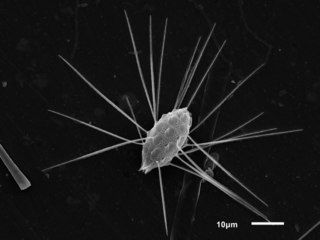
The Chlorophyceae are one of the classes of green algae, distinguished mainly on the basis of ultrastructural morphology. They are usually green due to the dominance of pigments chlorophyll a and chlorophyll b. The chloroplast may be discoid, plate-like, reticulate, cup-shaped, spiral- or ribbon-shaped in different species. Most of the members have one or more storage bodies called pyrenoids located in the chloroplast. Pyrenoids contain protein besides starch. Some green algae may store food in the form of oil droplets. They usually have a cell wall made up of an inner layer of cellulose and outer layer of pectose.

Chlamydomonas is a genus of green algae consisting of about 150 species of unicellular flagellates, found in stagnant water and on damp soil, in freshwater, seawater, and even in snow as "snow algae". Chlamydomonas is used as a model organism for molecular biology, especially studies of flagellar motility and chloroplast dynamics, biogenesis, and genetics. One of the many striking features of Chlamydomonas is that it contains ion channels (channelrhodopsins) that are directly activated by light. Some regulatory systems of Chlamydomonas are more complex than their homologs in Gymnosperms, with evolutionarily related regulatory proteins being larger and containing additional domains.

Pyrenoids are sub-cellular micro-compartments found in chloroplasts of many algae, and in a single group of land plants, the hornworts. Pyrenoids are associated with the operation of a carbon-concentrating mechanism (CCM). Their main function is to act as centres of carbon dioxide (CO2) fixation, by generating and maintaining a CO2 rich environment around the photosynthetic enzyme ribulose-1,5-bisphosphate carboxylase/oxygenase (RuBisCO). Pyrenoids therefore seem to have a role analogous to that of carboxysomes in cyanobacteria.

Chlamydomonas reinhardtii is a single-cell green alga about 10 micrometres in diameter that swims with two flagella. It has a cell wall made of hydroxyproline-rich glycoproteins, a large cup-shaped chloroplast, a large pyrenoid, and an eyespot apparatus that senses light.
Neochloris oleoabundans is a microalga belonging in the class Chlorophyceae. Due to its high lipid content, it has been considered as a candidate organism for cosmetics and biofuel production, as well as feed stock for freshwater mussels.

Tetraselmis is a genus of phytoplankton. Tetraselmis is a green algal genus within the order Chlorodendrales, and they are characterized by their intensely-colored green chloroplast, their flagellated cell bodies, the presence of a pyrenoid within the chloroplast, and a scale-produced thecal-wall. Species within this genus are found in both marine and freshwater ecosystems across the globe; their habitat range is mainly limited by water depth due to their photosynthetic nature. Thus, they live in diverse water environments if enough nutrients and light are available for net photosynthetic activity. Tetraselmis species have proven to be useful for both research and industry. Tetraselmis species have been studied for understanding plankton growth rates, and recently a colonial species is being used to gain an understanding of multicellularity evolution. Additionally, many species are currently being examined for their use as biofuels due to their high lipid content.

Eustigmatophytes are a small group of eukaryotic forms of algae that includes marine, freshwater and soil-living species.

The eyespot apparatus is a photoreceptive organelle found in the flagellate or (motile) cells of green algae and other unicellular photosynthetic organisms such as euglenids. It allows the cells to sense light direction and intensity and respond to it, prompting the organism to either swim towards the light, or away from it. A related response occurs when cells are briefly exposed to high light intensity, causing the cell to stop, briefly swim backwards, then change swimming direction. Eyespot-mediated light perception helps the cells in finding an environment with optimal light conditions for photosynthesis. Eyespots are the simplest and most common "eyes" found in nature, composed of photoreceptors and areas of bright orange-red red pigment granules. Signals relayed from the eyespot photoreceptors result in alteration of the beating pattern of the flagella, generating a phototactic response.

Gonium is a genus of colonial algae, a member of the order Chlamydomonadales. Typical colonies have 4 to 16 cells, all the same size, arranged in a flat plate, with no anterior-posterior differentiation. In a colony of 16 cells, four are in the center, and the other 12 are on the four sides, three each. A description by G.M. Smith :
Gonium Mueller 1773: Colonies of 4-8-16 cells arranged in a flat quadrangular plate and embedded in a common gelatinous matrix or connected by broad gelatinous strands. Cells ovoid to pyriform, with a single cup-shaped chloroplast containing one pyrenoid. Each cell with two cilia of equal length, contractile vacuoles at the base of the cilia, and an eyespot. Four- and eight-celled colonies with the cilia on the same side ; sixteen-celled colonies with the four central cells having their cilia on the same side and the twelve marginal cells with radially arranged cilia.
Asexual reproduction by simultaneous division of all cells in the colony to form autocolonies, or by a formation of 2-4 zoospores in each cell.
Sexual reproduction isogamous, by a fusion of biciliatezoogametes.

Chlamydomonadaceae is a family of algae within the order Chlamydomonadales. Traditionally, it has been defined as containing single-celled flagellates with a cell wall.
Asteromonas is a genus of green algae in the family Asteromonadaceae. It has been described from saline, marine, and brackish environments. It is closely related to the genus Dunaliella, another genus common in saline waters.

Brachiomonas is a genus of thalloid biflagellate green algae. These algae generally are found in marine or brackish waters, but can tolerate wide range of salinities. They may occur in freshwater pools near the sea and, occasionally, in polluted inland freshwater habitats.

Chloromonas is a genus of green algae in the family Chlamydomonadaceae. It is closely related to the model green algae, Chlamydomonas, and traditionally has been distinguished mainly through the absence of a pyrenoid.

Tetraspora is a genus of green algae in the family Tetrasporaceae of the order Chlamydomonadales, division Chlorophyta. Species of Tetraspora are unicellular green algae that exist in arrangements of four and consist of cells being packaged together in a gelatinous envelope that creates macroscopic colonies. These are primarily freshwater organisms, although there have been few cases where they have been found inhabiting marine environments and even contaminated water bodies. Tetraspora species can be found all around the globe, except in Antarctica. Despite the ubiquitous presence, the greatest growth of the genera's species is seen in the polar climatic zones.
Geminigera /ˌdʒɛmɪnɪˈdʒɛɹə/ is a genus of cryptophyte from the family Geminigeraceae. Named for its unique pyrenoids, Geminigera is a genus with a single mixotrophic species. It was discovered in 1968 and is known for living in very cold temperatures such as under the Antarctic ice. While originally considered to be part of the genus Cryptomonas, the genus Geminigera was officially described in 1991 by D. R. A. Hill.

Hirticlavula is a fungal genus in the family Clavariaceae. It contains a single described species, Hirticlavula elegans. Formally described in 2014, the fungus has been collected from Norway and Denmark. H. elegans produces white fruit bodies up to 1.1 millimetres (0.043 in) in height. Each fruit body contains a fertile head atop a hairy stem. The fruit bodies grow directly from dead bark or wood, where they feed as saprotrophs. Both morphological and ecological details are distinctive when compared to other clavarioid fungi.

Mallomonas is a genus comprising unicellular algal eukaryotes and characterized by their intricate cell coverings made of silica scales and bristles. The group was first named and classified by Dr. Maximilian Perty in 1852. These organisms live in freshwater and are widely distributed around the world. Some well known species include Mallomonas caudata and Mallomonas splendens.
Torodinium (ˌtɔɹoʊˈdɪniəm) is a genus of unarmored dinoflagellates and comprises two species, Torodinium robustum and the type species Torodinium teredo. The establishment of Torodinium, as well as the characterization of the majority of its morphology, occurred in 1921 and further advances since have been slow. Lack of research is largely due to its extremely fragile and easily deformed nature, which also renders fossil records implausible. The genus was originally characterized by torsion of the sulcus and a posterior cingulum. Since then, new distinctive features have been discovered including an extremely reduced hyposome, a longitudinally ribbed episome, and a canal on the dextro-lateral side. Further investigation into the function of many anatomical features is still necessary for this genus.

Protists are the eukaryotes that cannot be classified as plants, fungi or animals. They are mostly unicellular and microscopic. Many unicellular protists, particularly protozoans, are motile and can generate movement using flagella, cilia or pseudopods. Cells which use flagella for movement are usually referred to as flagellates, cells which use cilia are usually referred to as ciliates, and cells which use pseudopods are usually referred to as amoeba or amoeboids. Other protists are not motile, and consequently have no built-in movement mechanism.

Chlamydomonas moewusii is a species of unicellular green alga belonging to the genus Chlamydomonas. C. moewusii is typically a freshwater species and occupies a significant position as a model organism for various scientific studies due to its relatively simple cellular structure and ease of cultivation.















